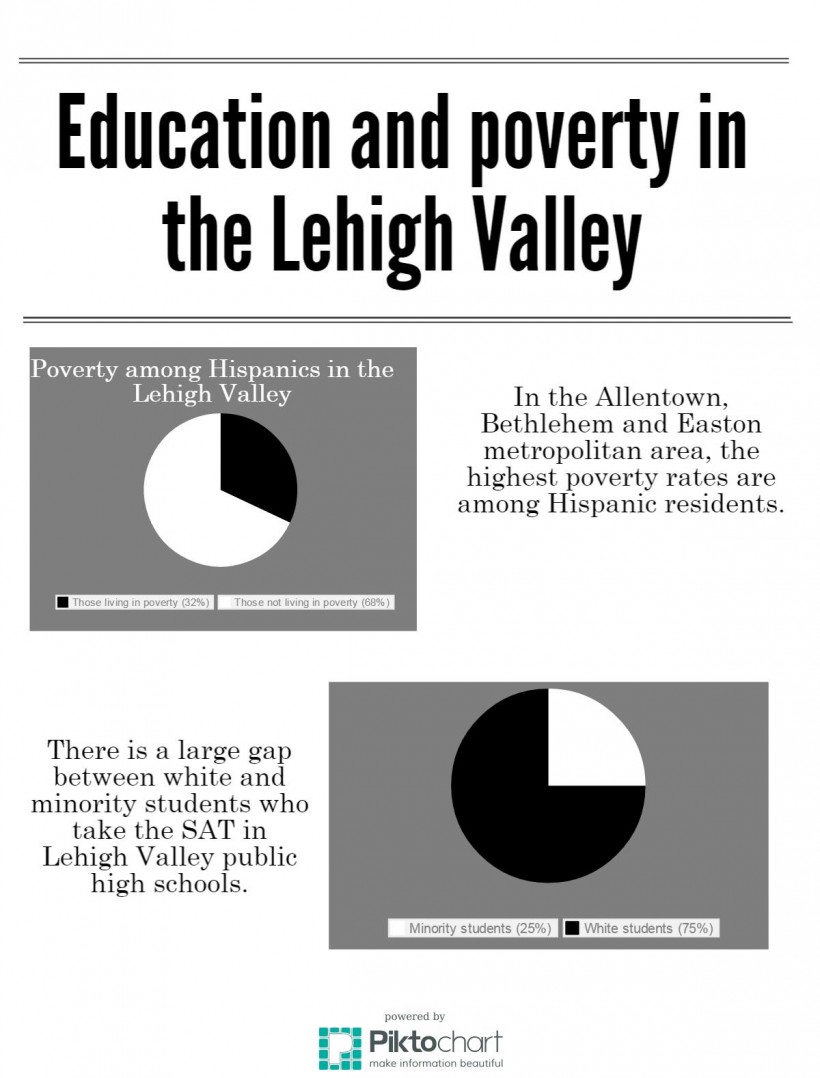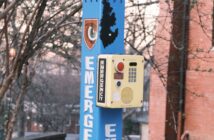In 1997, Victoria Montero was 10 years old when her family moved from Guanajuato, Mexico, to Bethlehem to provide her with a better future.
Now 27, Montero describes her younger self as a shy and quiet girl whose parents didn’t speak English and never attended college. Although her family was supportive of her education, Montero came from a low-income household.
Montero is not the only Hispanic resident in the Lehigh Valley who faces difficult barriers in adjusting to a new culture and attaining higher education.
In Spring 2014, the Community Action Committee of the Lehigh Valley formed the Task Force on Wealth Disparity. The force examines the status of Lehigh Valley’s historically under-represented populations.
According to their 2014 research project titled “Disparity in the Lehigh Valley: The trends across income and education,” extreme ethnic disparities exist in the areas of poverty, income and education.
The report states that in the Allentown-Bethlehem-Easton Metropolitan Statistical Area, also known as the ABE MSA, the highest poverty rates are among Hispanic residents at 32 percent of the Hispanic population. The median income for white individuals living in the ABE MSA is $57,983 compared to only $35,747 for Hispanic individuals.
Elizabeth Deegan, a member of the Lehigh Valley Research Consortium, helped gather and analyze this data. Deegan joined the research center because she wanted to tackle these issues and discover opportunities for students in need.
“When we are looking at educational outcomes, we find that poverty strongly correlates to student achievement,” Deegan said. “The Latino population in particular has a high correlation to poverty, but also the problem of the language barrier.”
In an internal school district evaluation, it was found that students enrolled in the English as a Second Language program, also known as ESL, were not engaged in academics, and there were high teen pregnancy and drop out rates.
Deegan said census data shows only 13 percent of Hispanic Americans in the ABE MSA earn a bachelor’s degree or higher. As of 2009, 75 percent of students taking the SATs in the Lehigh Valley public schools were white.
Julie Vitale is a youth workforce coordinator who works at a drop-in CareerForce center in the William Allen and Dieruff High Schools in Allentown. Vitale is passionate about identifying youth that are at risk of dropping out, and said schools should have systems to help alleviate common challenges.
Vitale receives a list of youth from the administration who are considered at-risk based on attendance, grades and behavioral incidents. In the 2013-2014 school year, 293 students were identified as at-risk youth in the two Allentown high schools. Out of 4,456 students enrolled in the two schools, a total of 256 individuals dropped out before the end of the year.
Vitale said some reasons why students struggle to be successful in school include homelessness, poverty, substance abuse of the student or family, neglect, responsibility for younger siblings and teen pregnancy.
“I have known students facing situations that would be outrageously difficult for an adult, much less a young person to endure,” Vitale said. “I have witnessed how so many students have obstacles that certainly don’t give them the same advantage as other kids.”
Vitale said mentor and career planning programs are the most effective methods to help this population of students prepare for their future beyond high school. She referred to one program in particular that has achieved major success in the Lehigh Valley.
In 1997, the School-To-Work program was created between St. Luke’s Hospital and the Bethlehem Area School District. The program exposes 18 students per year to different health care careers at the hospital. Each student rotates between shadowing and observing 30-40 different departments in an academic year.
School-To-Work teaches students job skills, how to dress and communicate professionally, as well as prepare for an interview and create a resume. Sophomore, junior and senior students must apply, interview and maintain a C average in their academic classes to participate.
Since its establishment, School-To-Work has had a 95.5 percent graduation rate and several participants are now employed at the hospital.
One of those students is Montero.
Montero applied and was accepted to the School-To-Work program during her sophomore year. She said she did well in the program and got a job after school in the health department at the hospital. Through the help of her mentor, Montero applied to community college and continued to work at St. Luke’s part time for the hospital’s youth programs.
Today, Montero is the manager of all adolescent career-mentoring programs at St. Luke’s Hospital.
“The School-To-Work program opened the door to my future, to my career, to the woman I have become today,” Montero said. “It gave me the passion for the work that I do now.”
Montero said the program gives students an opportunity to get involved in something they never imagined could be possible in their lives. She said mentoring helps students break the cycle of poverty in their families and encourages them to go to college and have a career.
Through mentoring, Montero said students learn to trust their mentor and develop personal goals, which has led to the success of the program.
Montero often keeps in touch with former students and said it is gratifying to hear when the students she mentored are succeeding in their careers.
“I just received a letter from a past student this morning and I was crying as I read her letter,” Montero said.
Montero remembers this student because she started the program as a 19-year-old single mother. By the time she finished the program, she had three job offers and accepted the job with the highest salary.
In the letter, the girl included a picture of her daughter. She said because of the opportunity she received from the mentoring program, she was able to buy a home, a car and change the quality of life for her daughter.
Although the School-To-Work program has many success stories, there is still a high percentage of at-risk youth in the Lehigh Valley. Montero said establishing programs to help these students who face the same challenges she experienced is the key to increasing minority student achievement.
MORE: Many students in the Lehigh Valley are unaware of career opportunities. Several CareerForce centers have been developed in the area to connect students with these jobs.






Comment policy
Comments posted to The Brown and White website are reviewed by a moderator before being approved. Incendiary speech or harassing language, including comments targeted at individuals, may be deemed unacceptable and not published. Spam and other soliciting will also be declined.
The Brown and White also reserves the right to not publish entirely anonymous comments.